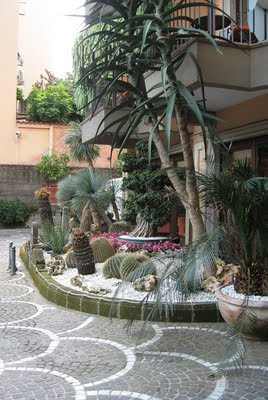A shuttle picked us up from the Hotel Diana and transferred us to the tour bus that would carry us south from Rome to our first stop, the city of Naples. Travelling along the modern highway, we saw the Appian Way, lined on both sides by rows of umbrella pines. This ancient road ran southeast from Rome, to Brindisi on Italy's Adriatic coast.
We arrived at the port of Naples in the rain, and regrouped with other English-speaking travellers for our walking tour.
 |
| Castel Nuovo, Naples |
Our guide showed us the Castel Nuovo, the Opera House, the Umberto I Galleria and the Royal Palace. I would have preferred, however, to spend my time here at the Naples National Archaeological Museum viewing artifacts from Pompeii and Herculaneum.
 |
| Umberto I Galleria, Naples |
When we reached the town of Pompeii, we were taken through a shop selling red coral jewellery, and to the Hotel Vittoria for lunch (included) before entering the site.
 |
| Juice Stand, Pompeii |
Once everyone was equipped with an audio system, our guide led us up the stone ramp to Porta Marina, the arched entrance in the ancient city wall.
 |
| Porta Marina Entrance to Pompeii |
Mount Vesuvius was shrouded in clouds and barely visible in the distance, but its menacing presence could be felt.
 |
| Mount Vesuvius, Pompeii |
We crossed the stepping stones that were positioned to keep feet dry when streets were flooded for cleaning, while still allowing chariot wheels to pass.
 |
| Stepping Stones in Pompeii Street |
We viewed pottery that had survived the eruption, and plaster casts of those unfortunate citizens of Pompeii who had not.
 |
| Plaster Cast of Pompeii Victim |
If you are visiting Pompeii on your own without a guide, I would recommend Rick Steves' Self Guided Tour from his Rome guidebook
Not long after we departed from Pompeii, we reached the Sorrentine peninsula along a winding coastal road that edged the sea.
 |
| Sorrentine Peninsula |
I had hoped that we would be lodging at the Grand Hotel Ambasciatori during our stay in Sorrento. My online research had discovered a scenic cliff-top location for this hotel. But we were booked into the Hotel Michelangelo. My initial disappointment was tempered by the Michelangelo's great location on Sorrento's main thoroughfare, Via Corso Italia.
 |
| Hotel Michelangelo, Sorrento |
 |
| Hotel Michelangelo, Sorrento |
 |
| Hotel Michelangelo Front Garden |
After dinner (included) in the hotel dining room, we ventured out to discover Sorrento. It was time for the evening passeggiata, and the street was restricted to pedestrian traffic for this nightly event. Souvenir and gelato shops remained open, orange trees and huge pots of petunias lined the sidewalks, and the town felt very safe as tourists and local families mingled in the street.
 |
| Flowers on Via Corso Italia, Sorrento |
We heard that the travellers bound for the Isle of Capri this morning had not been able to make the crossing due to rough seas. With the heavy clouds overhead, I feared for our own planned visit the next day.
Next: The Isle of Capri
No comments:
Post a Comment
All comments are moderated.
Note: only a member of this blog may post a comment.